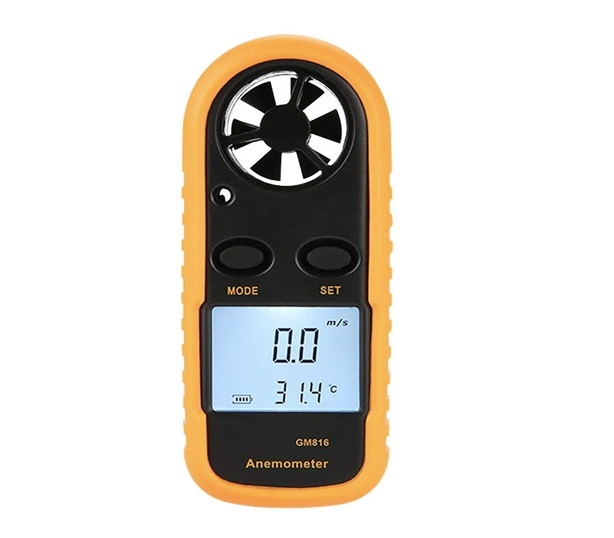What is an Air Measurement Device?

Air measurement devices are instruments used to measure the properties of air including temperature, humidity, pressure, and air quality. They are essential in the air conditioning, heating, ventilation, and refrigeration industry. Air measurement devices can take accurate, reliable measurements in real time for both residential and industrial applications. Airflow measurement helps to ensure energy efficiency, balance, and cost-effectiveness of the system. The best way to verify these is from the instrument called Anemometers or thermoanemometers (if they measure temperature). It measures air volume, airflow, humidity, temperature, pressure, and dew point.
Anemometers are available in two different technologies, hotwire anemometers and vane anemometers. Hotwire are the most commonly used anemometers as it provides a wider airflow range measured. Manometers also measure air velocity and volume but are widely used to measure the static and differential pressure of a system. Direct measurement of air volume is done through supply and exhaust readings of diffusers and grilles by capture hoods. So, here in this blog, we will be discussing the device, types of anemometers, components, and their uses.
Vane Anemometer
A vane anemometer operates by the airflow stream that hits the vane, which makes it rotate. The rotation of the blades of the vane is perceived by an optical or magnetic sensor, which further converts the signal to a direct Feet Per Minute (FPM) velocity measurement. It can average air velocities at supply openings, filter banks, and walk-in ducts. By entering the square feet of the vent, it can even calculate Cubic Feet per Minute(CFM) calculations.
The vastly common vane diameter is four inches in length containing ball bearings to prevent or minimize friction during the rotation of blades. The direction in which the airflow must travel through the vane is identified by an arrow on the vane head to acquire proper measurements. An average measurement range from 50 to 6000 FPM is provided by the device.
Mechanical vane anemometers are also known as swinging vans. They are effortless to use and didn’t use power or batteries to provide direct air velocity measurements. When an air stream goes inside a chamber it stirs the swing vane, which is directly associated with an FPM measurement. It creates smooth and accurate movement as the motion of the vane is frictionless.
Hotwire Anemometers
Hotwire anemometers function on the principle of heat transfer. The wire element is heated more than the ambient temperature by enacting current by electrical resistance, which further converts the energy to heat. The heat is then departed into the air passing from the heated wire element. To maintain the initial temperature at zero airflow the meter sends more power to the already heated wire. This transforms the power signal into an air velocity measurement that is shown on the LCD of the device.
Hot-wire anemometers attribute small diameter searches that allow to take measurements in tight spaces and hard-to-reach regions. With an average of 0 to 10,000 FPM, it becomes an ideal test and measurement device for low-flow applications. It has maximum temperature tolerance of 200°F, which limits its usage in ambient conditions.
Components of Air Measurement Devices
Air measurement devices mainly consist of four components:
- Sensors: Sensors are responsible for detecting physical changes within the environment, converting them to electrical signals, and transmitting them to other devices. The sensors used in air measurement devices are temperature sensors, humidity sensors, airflow sensors, and air quality sensors.
- Microprocessor: A microprocessor is the electronic circuitry that performs various calculations and processes gathered data from the sensors.
- Display: A display is the output interface where users can view data in real-time on the devices. Generally, LCDs are used on most air measurement devices.
- Power supply: The electronic components of air measurement devices need electrical power to work correctly. They can be powered by batteries or connected to a power supply.
Uses of Air Measurement Devices
Here are some applications of air measurement devices.
HVAC: Air measurement devices are widely used in the heating, ventilation, and air conditioning (HVAC) industry. HVAC professionals use these devices to monitor and control temperature, humidity, and pressure to make sure the working environment is comfortable for the occupants.
Industrial use: Air measurement devices are used in many industrial applications, including factories or refineries that require temperature, pressure, or airflow control.
Medical use: Air measurement devices are also used in hospitals, laboratories, and medical manufacturing facilities to ensure the air quality is clean and safe from particles and other potentially harmful substances.
Home use: Air measurement devices can be used in homes to monitor temperature, humidity, and air quality. It helps homeowners measure and improve air quality for their families health, especially for those with allergies or asthma.
Conclusion
Air measurement devices (https://adkinstruments.in/categories/air-quality/air-quality-meter) play a critical role in controlling and maintaining healthy working or living environments. They provide accurate and reliable measurements of air properties in real time. We hope this article will give you a better understanding of the components and uses of air measurement devices.